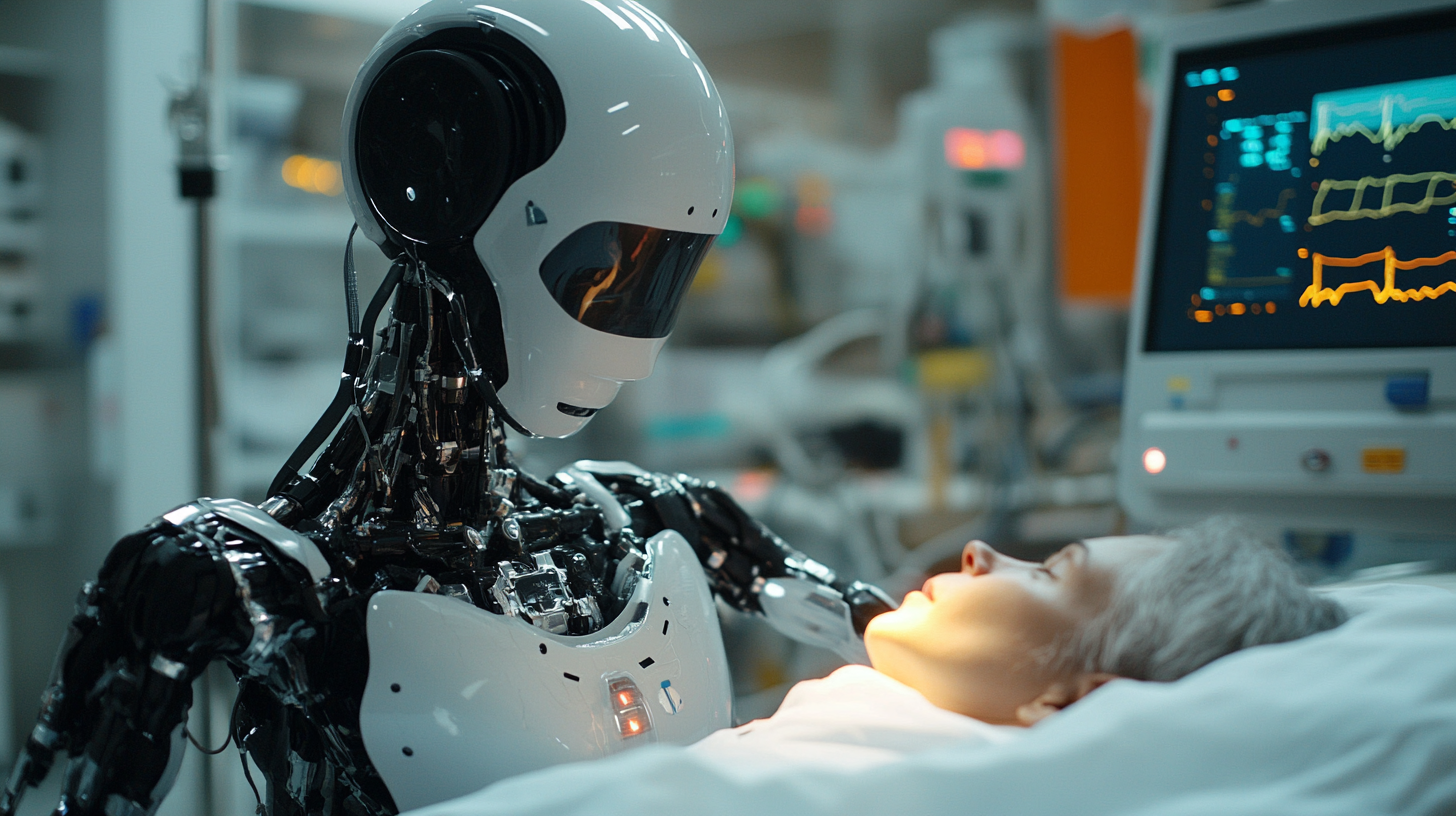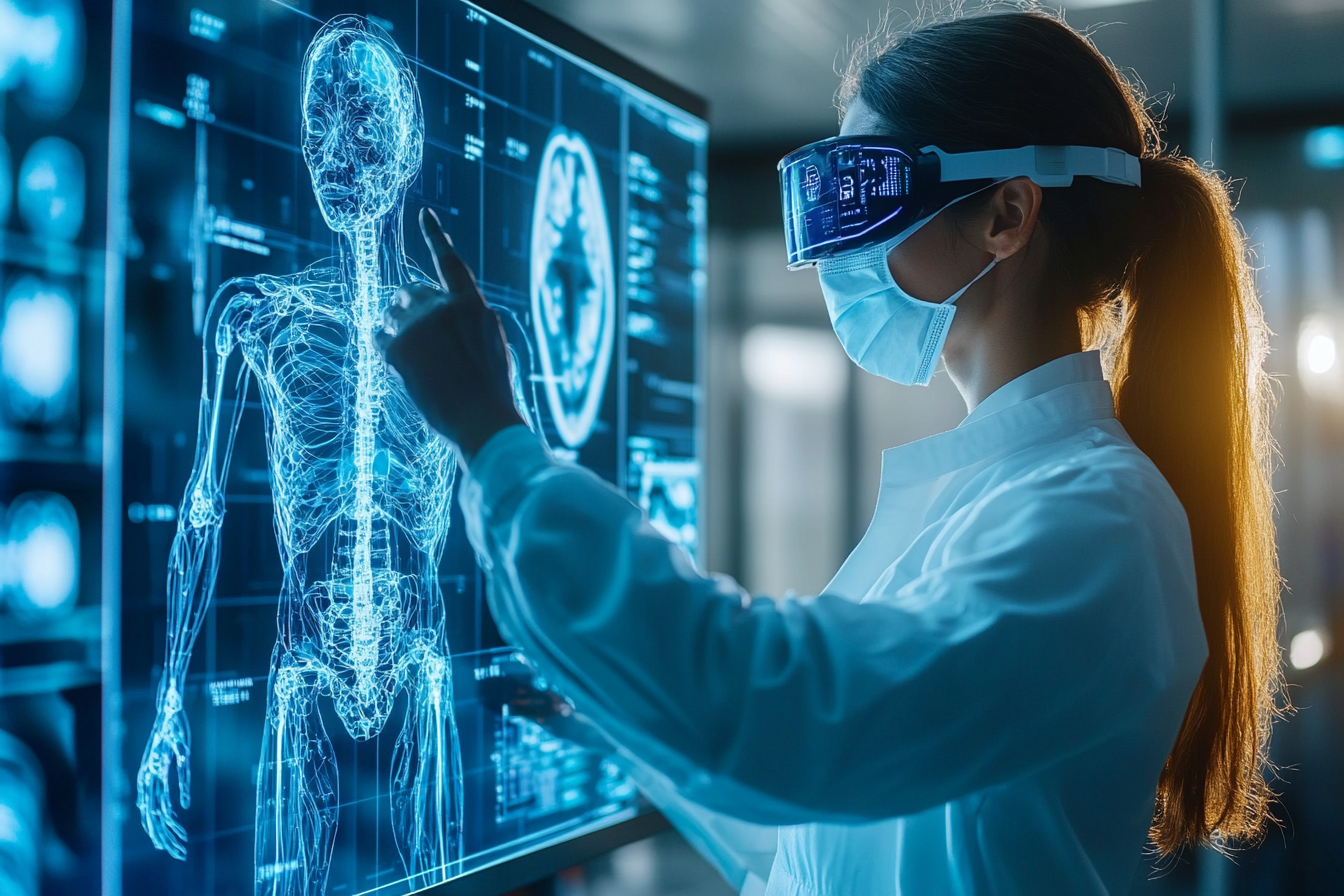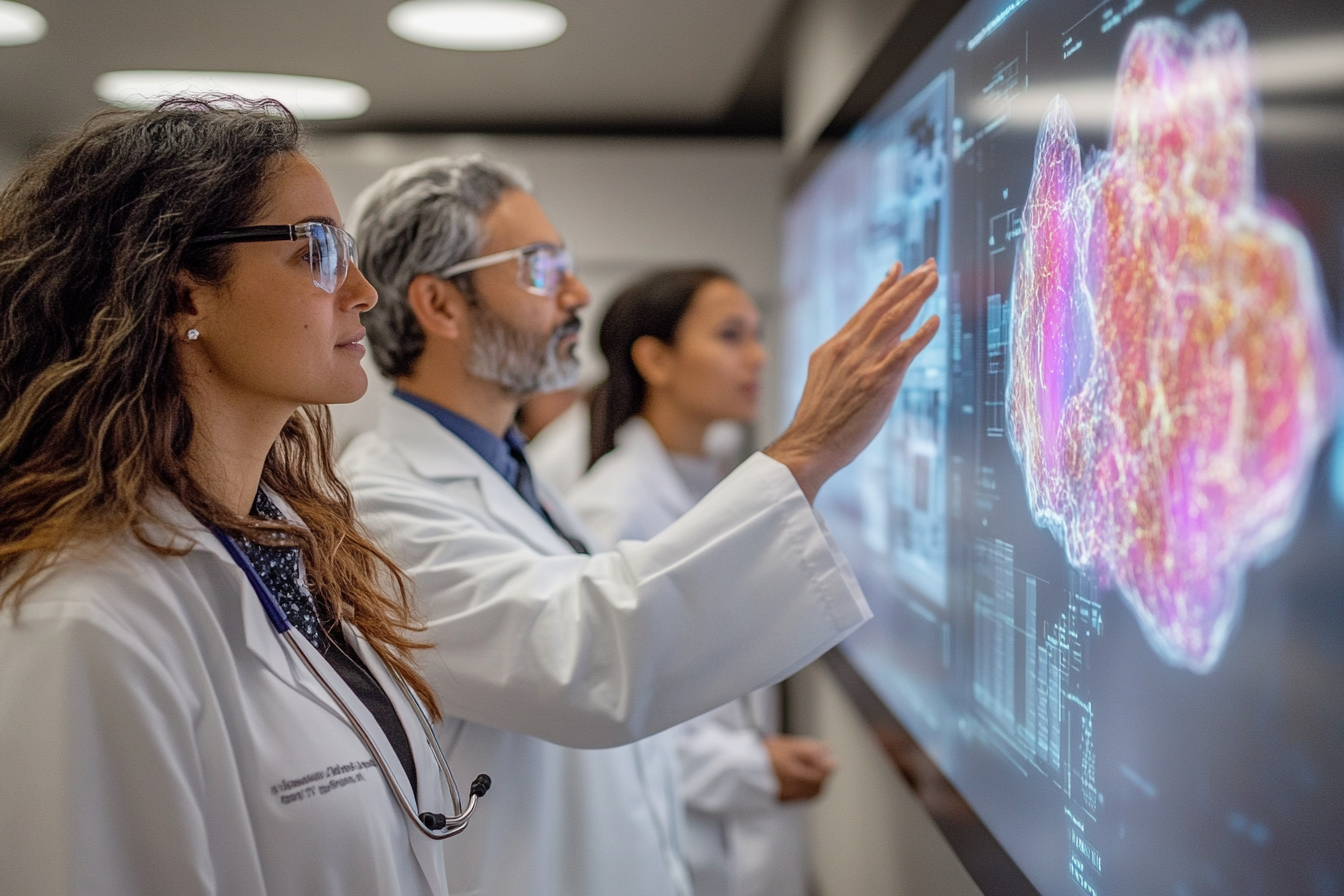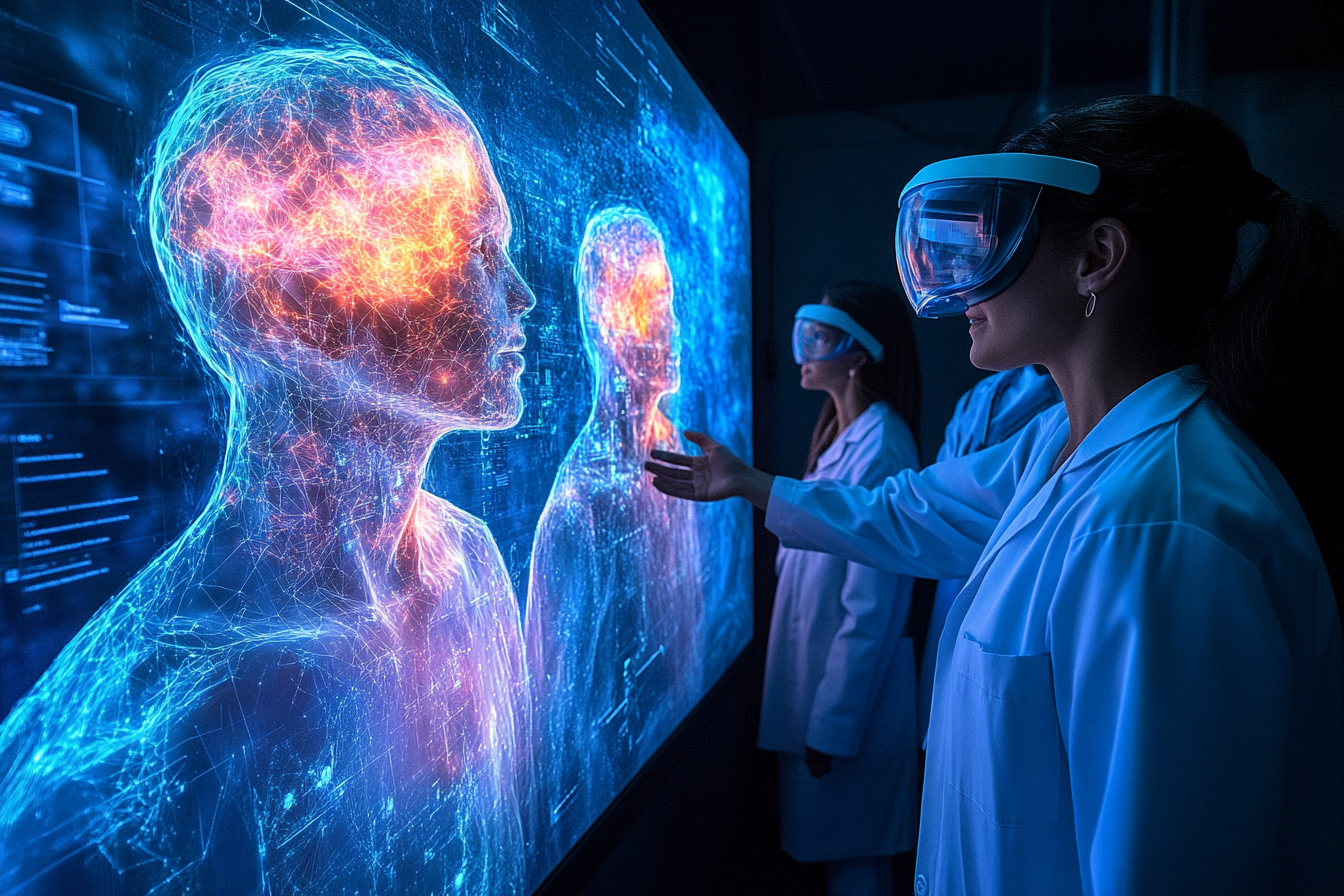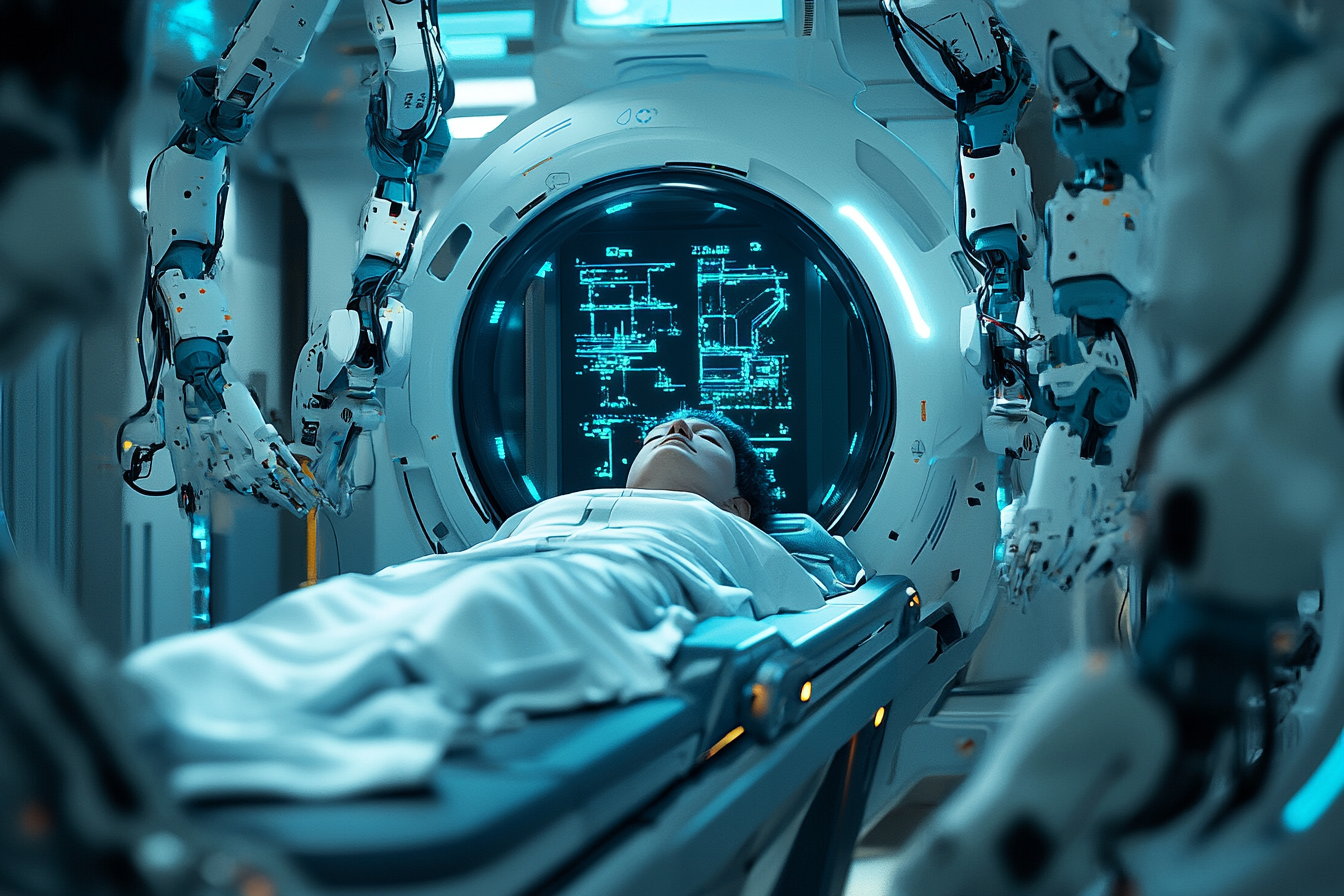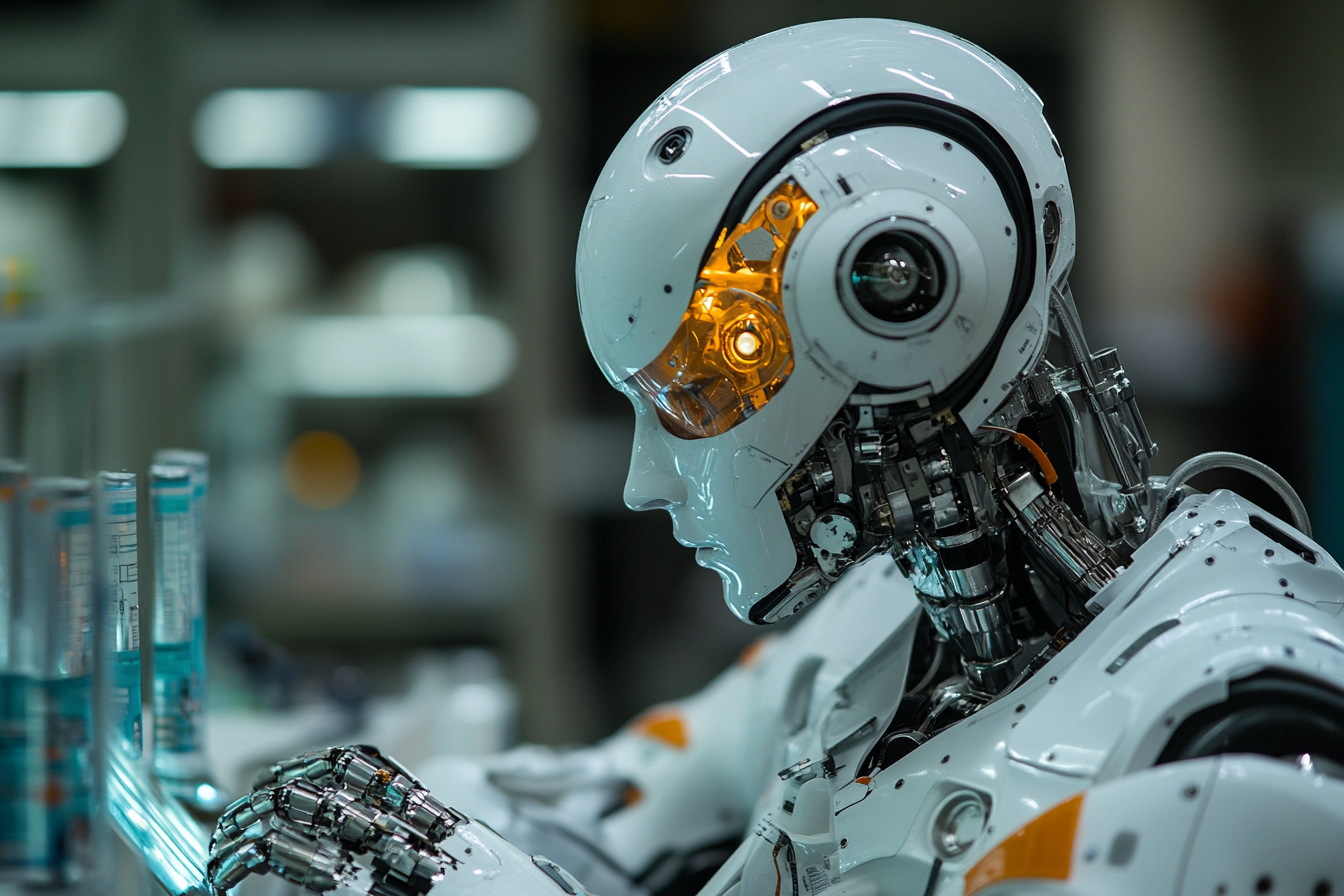AI in Healthcare- January 2025 Report
Artificial intelligence (AI) is rapidly transforming various sectors, and healthcare is no exception. Its applications span from diagnosing diseases to developing new drugs. This article explores the ways AI is being utilized in healthcare, examining its current applications, potential benefits, and challenges.
Listen to Podcast
AI in Medical Imaging Analysis
AI is significantly improving image interpretation and analysis in medical imaging. AI algorithms can be trained to analyze medical images, such as X-rays, CT scans, and MRIs, and detect abnormalities that may be difficult for humans to perceive. This leads to more accurate and efficient diagnoses and treatment of various conditions.
Disease Detection
AI algorithms can identify patterns and abnormalities in medical images that may not be visible to the human eye, leading to more accurate and timely diagnoses. For example, AI can match or even surpass the accuracy of human radiologists in detecting pneumonia in chest X-rays. AI can also analyze data points in a medical report to distinguish a disease from a healthy part and signals from noise. AI Large Language Models are primarily utilized in medical imaging equipment for enhancing diagnostic accuracy, automating the interpretation of medical images, and improving the overall efficiency of diagnostic processes.
Precision Medicine
AI is being used to improve the accuracy of precision medicine. AI integration supports precision medicine by combining imaging data with patient history and genetic information, creating comprehensive profiles for personalized treatment plans. For instance, AI and machine learning tools can differentiate between different types of lung cancer, enabling the most appropriate therapy. AI-enabled medical imaging can also more accurately predict the survival rate of tumor patients based on the measured grade and stage. With these accurate measurements, doctors can adopt a personalized treatment plan designed for the patient’s condition.
Workflow Optimization
One of the primary applications of AI in medical imaging is aiding in the diagnosis and detection of diseases. Deep learning algorithms have demonstrated remarkable capabilities in identifying subtle abnormalities within medical images. For example, AI has shown promising results in the early detection of diseases like cancer, enabling earlier intervention and improved patient outcomes. AI-powered algorithms can analyze large datasets of medical images with unparalleled speed, assisting radiologists in making more accurate diagnoses.
AI techniques can enhance the quality of medical images, improving the visibility of important structures and reducing artifacts caused by various factors such as motion or noise. AI algorithms can also reconstruct high-quality images from lower-quality inputs, which is particularly useful in scenarios where image acquisition might be limited.
AI has the potential to streamline medical imaging workflows. Routine tasks, such as image acquisition, annotation, and reporting, can be automated, allowing medical professionals to focus on more complex tasks that require human expertise.
Key Insight: The integration of AI in medical imaging analysis has markedly improved diagnostic accuracy. It reduces human error and enhances the detection of diseases at their early stages. This shift towards AI-enhanced diagnostic methods is reshaping the landscape of medical imaging technology and precision medicine.
AI in Predictive Analytics for Disease Detection
AI is being applied in predictive analytics to help healthcare providers anticipate patient outcomes. By analyzing historical data, AI can predict patient outcomes, which aids in preventive care and personalized treatment plans. A prominent example is the BlueDot platform, which uses AI to scan global news reports, airline data, and other sources to predict the spread of infectious diseases. BlueDot successfully flagged the COVID-19 outbreak days before official alerts were issued, demonstrating AI’s potential to enhance disease surveillance and response. A notable example is the use of AI in detecting diabetic retinopathy, a leading cause of blindness.
In chronic disease management, such as in the case of diabetes, AI technology can monitor a patient’s glucose levels in real-time and recommend custom diet and medication plans to regulate blood sugar. The targeted treatment optimizes the overall efficiency of healthcare systems by reducing unnecessary treatments and hospitalizations for chronic conditions.
A study published in Nature Medicine in 2024 showcased the potential of AI in lung cancer detection. Researchers developed an AI system that analyzes chest X-rays to detect lung cancer.
AI tools expedite the process of patient health evaluation, as well as deliver rapid and comprehensive assessment findings identifying patient-risk profiling for disease predictions. Zebra Medical Vision’s AI-powered algorithm is designed to detect brain bleeds with remarkable accuracy, enabling early diagnosis and timely, life-saving interventions. This technology interfaces seamlessly with existing imaging systems, amplifying their power to give healthcare professionals a strong lead in light of their drive to improve patient outcomes and reduce time to treatment in key scenarios. Clinical studies have shown that Zebra’s algorithm beats the manual approach to detecting brain hemorrhages, being much quicker and more sensitive.
AI-Guided Robotic Surgery
AI is playing an increasingly important role in robotic surgery, enhancing the capabilities of surgical robots and improving surgical outcomes. AI-assisted techniques in robotics now extend from preoperative planning to intraoperative guidance and postoperative care.
One example of an end-to-end robotic system is Senhance by Asensus Surgical, which in 2021 was cleared by the FDA for general surgeries. Senhance allows surgeons to create simulations for preoperative planning, while also providing real-time data for intraoperative guidance and generating insightful analytics for postoperative performance assessments and care.
Current AI-driven robotic surgical systems incorporate various functionalities, including image recognition and segmentation. AI algorithms can analyze surgical field images in real-time to identify critical structures, blood vessels, and tumors, aiding surgeons in decision-making.
Decision Support Systems
AI-powered decision support systems can provide evidence-based recommendations to clinicians at the point of care. These systems utilize various inputs to generate valuable outputs that aid in surgical decision-making.
| Decision Support System | |
|---|---|
| Input | Output |
| Customized Risk Evaluation | |
|
|
| Intraoperative Guidance | |
|
|
| Postoperative Care | |
|
|
AI in robotic surgery promises to fill the gap and propel the surgical robotics market toward $21.41 billion by 2030. Additionally, AI’s diagnostics capabilities significantly reduce unnecessary surgeries, with one study highlighting a drop in error rates for detecting cancerous lymph nodes from 3.4 to 0.5 percent.
AI is poised to revolutionize surgery by making hospital and health system operations more efficient and less costly and help address stresses such as workforce shortages. For example, by estimating how much time is left in the surgery, AI will help hospitals better plan their available hospital bed resources and more accurately inform the patient’s family when the surgery might be completed. Converting a percentage of open cases to robotics could reduce surgical times, enable more cases to be done each day, reduce complications such as blood loss and surgical site infections, reduce length of stay, increase patient access, and decompress hospital inpatient populations.
Based on its review of millions of surgical videos, AI has the ability to anticipate the next 15 to 30 seconds of an operation and provide additional oversight during the surgery. In the future, anticipation of surgical events could allow surgeons to change their courses of action, if necessary.
Intuitive believes that the transparent, responsible, and secure use of data can bring increasing value to the operating room. A particular area of interest that holds enormous promise is the use of big data and AI in surgery. It could help medical students and residents learn more quickly and efficiently; improve the ability to identify which patients are most likely to benefit from minimally invasive surgery; and help surgeons make better decisions in the OR.
Experts anticipate that the integration of AI and machine learning algorithms into robotic surgery will play a more prominent role in the future. These technologies can assist in real-time decision-making, improve surgical planning, and enhance the precision of robotic procedures.
Levels of Autonomy in Robotic Surgery
Despite initial skepticism among some surgeons, advances in AI and robotics are paving the way for increased autonomy in surgical procedures. While the absence of haptics has traditionally hindered the widespread adoption of robotic surgery, there is growing recognition within the surgical community of the true potential of robotics. Consequently, the integration of AI is becoming increasingly crucial, offering new avenues for enhancing surgical precision and outcomes.
| Level | Description |
|---|---|
| Level 0: No Automation | Traditional surgery: Human performs all surgical tasks; includes open, laparoscopic, and robotic-assisted surgery where the surgeon directly manipulates the instruments. |
| Level 1: Robot Assistance | e.g., Robot holds a retractor or endoscope; the robot provides assistance to the surgeon, but the surgeon remains in control. |
| Level 2: Task Automation | e.g., Automated suturing with human supervision; the robot can perform specific tasks autonomously, but the surgeon oversees the process. |
| Level 3: Conditional Automation | e.g., Automated bone drilling to prespecified depth with human setup; the robot can perform certain procedural steps without human input. |
| Level 4: High Automation | e.g., Automated skin closure; the robot can perform a significant portion of the surgical procedure with minimal human intervention. |
| Level 5: Full Automation | e.g., Fully automated cholecystectomy; akin to autopilot in space flight; Robot is making all surgical decisions with no human input. |
Key Insight: Robotic surgery is now becoming the new standard for many surgical procedures, and the shift from “robotic-assisted” to “AI-assisted” surgery is just a matter of time.
Impact of AI on Patient Outcomes
AI has made significant strides in enhancing the accuracy and speed of disease diagnosis. AI-powered diagnostic tools, such as those used in radiology, can analyze medical images with a level of precision that rivals human experts and traditional methods. For example, AI algorithms can detect early signs of diseases like breast cancer, tuberculosis, and even COVID-19 from X-rays and CT scans, often identifying anomalies that may be overlooked by human eyes.
Accurate and timely medical diagnosis is crucial for early detection and better treatment outcomes, and using AI to assist provides numerous benefits, including faster and more precise diagnoses, early disease detection, and personalized treatments. It also automates routine tasks, easing the workload for healthcare professionals and detects subtle patterns in medical data that humans might miss. AI serves as a promising safeguard against such errors, offering an extra layer of scrutiny and impartiality in the diagnostic process.
Artificial intelligence is reshaping the way we approach patient care and treatment decisions. By integrating AI as part of diagnostic services, healthcare organizations are facilitating faster diagnoses and treatment decisions that improve patient outcomes. New tools can help support the earlier identification of disease, streamline workflows and alleviate employee burnout.
AI is transforming healthcare by improving diagnostic accuracy, enabling earlier disease detection, and enhancing patient outcomes. Effective and ethical AI solutions in healthcare require collaboration among AI engineers, data scientists, domain experts, and other stakeholders, which results in more effective AI models. AI-driven diagnostics are democratizing healthcare by making early and accurate diagnoses more accessible, especially in regions with limited access to specialized medical professionals. For example, Omdena’s AI-powered app in Liberia predicts malaria outbreaks and identifies high-risk areas, enabling health officials to take proactive measures, particularly for vulnerable groups such as children and pregnant women.
AI in diagnostics isn’t just about automation; it’s about augmenting the medical professional’s ability to make informed decisions. With AI, vast amounts of patient data can be analyzed swiftly, aiding in identifying diseases at their nascent stages. This not only speeds up the diagnostic process but also enhances the accuracy, allowing for early interventions that can significantly alter patient outcomes.
The integration of AI in diagnostics has far-reaching implications. It is not just improving the process of diagnosing diseases; it’s redefining the very essence of patient care. With AI, medical professionals can deliver more personalized and effective treatment plans, enhancing the overall healthcare experience for patients.
Key Insight: AI-driven diagnostics are democratizing healthcare by making early and accurate diagnoses more accessible, especially in regions with limited access to specialized medical professionals. This has the potential to address healthcare disparities and improve global health equity.
AI in Drug Discovery
AI accelerates drug discovery by analyzing vast datasets, predicting drug properties, and optimizing trial designs. This efficiency reduces research costs and shortens development timelines. AI streamlines target identification, lead optimization, and clinical trial processes, enabling more cost-effective and rapid drug discovery, ultimately benefiting pharmaceutical companies and patients.
AI-driven drug discovery streamlines identifying and validating potential molecular targets by analyzing diverse datasets, encompassing Drug Information Banks and public libraries. Employing techniques like deep autoencoder, relief algorithms, and binary classification, AI-based drug discovery effectively prioritizes these targets. Furthermore, AI platforms leverage graph-convolutional networks and computer vision models trained on cryo-EM microscope data to comprehend protein structures.
AI for drug discovery plays a crucial role in enhancing the accuracy and efficiency of various quality assurance processes in the domain of drug quality control. By employing computer vision algorithms for automated inspection, AI assists in identifying defects, contamination, and packaging inconsistencies. This ensures that drugs meet strict quality standards.
One approach to drug repurposing is computational drug repositioning. This involves analyzing large datasets of drug and disease information to identify potential new uses for existing drugs. AI algorithms can be used to identify patterns and relationships between drugs and diseases and use these patterns to predict which existing drugs may be effective for treating new diseases. According to Forbes, pharmaceutical companies can save nearly 70% of their costs by using AI for drug discovery.
Involvement of AI in the development of a pharmaceutical product from the bench to the bedside can be imagined given that it can aid rational drug design; assist in decision-making; determine the right therapy for a patient, including personalized medicines; and manage the clinical data generated and use it for future drug development.
AI-based approaches have the ability to improve the efficiency and accuracy of drug discovery processes and can lead to the development of more effective medications.
Key Insight: AI has the potential to streamline the drug discovery process, reduce the time and costs involved, and lead to the development of more effective and efficient treatments.
Ethical Considerations and Challenges of AI in Healthcare
The ethical issues with artificial intelligence in healthcare revolve around privacy and surveillance, bias and discrimination, as well as the role of human judgment. Where there is technology, there is always a risk of inaccuracy and data breaches. And, mistakes in healthcare can have devastating consequences for patients. Because there are no well-defined regulations on the legal and ethical issues relating to AI and the role it plays in healthcare, this is a crucial topic that needs to be explored.
Ethical considerations permeate every aspect of the development, implementation, and utilization of AI and ML in healthcare. From safeguarding patient privacy and ensuring data security to mitigating algorithmic biases and promoting transparency, ethical principles serve as the cornerstone of responsible AI adoption in healthcare. Moreover, the ethical implications of AI and ML extend beyond individual patient care to broader societal concerns, such as equity in access to healthcare services, the impact on healthcare disparities, and the redistribution of healthcare responsibilities among stakeholders.
One of the most noteworthy concerns with AI is the risk of bias in algorithms, which can inadvertently perpetuate existing health disparities. AI bias is a general concept that refers to the fact that an AI system has been designed in a way that makes the system’s decisions or use unfair. These AI data biases often arise from various sources, including the processes of data access, collection, acquisition, preparation, processing, development, and validation.
One specific type of bias is empathy bias. Empathy bias can occur when AI systems primarily rely on quantitative data, which can miss nuanced human experiences that affect health outcomes. It can also occur when AI systems do not consider patient preferences, values, and unique circumstances, leading to recommendations that are misaligned with patient needs.
Data security and privacy concerns stand as a huge challenge in the integration of AI into healthcare. Healthcare organizations handle vast amounts of sensitive patient data, making them a prime target for cyberattacks. The consequences of a data breach can be severe, potentially leading to identity theft, financial fraud, and compromising patient care.
Key Insight: The use of AI in healthcare has a great deal of potential, but it also comes with ethical issues that must be addressed. Policymakers need to ensure that these ethical issues are tackled proactively so that the benefit of AI outweighs the risk.
Conclusion
AI has the potential to revolutionize healthcare in many ways, from improving the accuracy and efficiency of diagnosis to accelerating drug discovery and personalizing treatment plans. AI is poised to transform healthcare delivery by:
- Improving diagnostic accuracy and efficiency: AI algorithms can analyze medical images and patient data with remarkable speed and precision, leading to earlier and more accurate diagnoses. This can significantly improve patient outcomes and survival rates, particularly for diseases like cancer, where early detection is crucial.
- Accelerating drug discovery: AI can streamline the drug discovery process, reducing the time and costs involved in developing new treatments. This can lead to the development of more effective medications and therapies for a wide range of diseases.
- Personalizing treatment plans: AI can analyze patient-specific data to develop personalized treatment plans that cater to an individual’s unique health needs. This approach moves away from the “one-size-fits-all” treatment model, resulting in more effective and targeted interventions.
- Democratizing healthcare: AI-driven diagnostics can make early and accurate diagnoses more accessible to underserved populations, particularly in regions with limited access to specialized medical professionals. This has the potential to address healthcare disparities and improve global health equity.
- Improving surgical outcomes: AI is playing an increasingly important role in robotic surgery, enhancing the capabilities of surgical robots and improving surgical precision. This can lead to less invasive procedures, faster recovery times, and better patient outcomes.
However, there are also challenges that need to be addressed to ensure the responsible and ethical implementation of AI in healthcare:
- Data privacy and security: Healthcare organizations must implement robust security measures to protect sensitive patient data from cyberattacks and breaches.
- Algorithmic bias: AI algorithms must be carefully designed and validated to avoid perpetuating existing biases and disparities in healthcare.
- Ethical considerations: Policymakers and healthcare professionals need to proactively address ethical concerns related to patient privacy, informed consent, and the responsible use of AI in clinical decision-making.
- Integration with existing workflows: AI systems need to be seamlessly integrated into existing healthcare workflows to maximize their efficiency and effectiveness.
As AI technology continues to evolve, it is crucial for healthcare professionals, researchers, and policymakers to work together to ensure that AI is used responsibly and ethically to improve patient outcomes and transform healthcare for the better. Continued research and development, ethical considerations, and collaboration among stakeholders will be essential in shaping the future of AI in healthcare.
